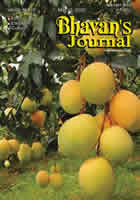Philippines, South East Asia, Israel, South Africa, Latin America, Mexico, Haiti, the Caribbean, California and Florida (both in the US) and Australia. In India there is a proliferation of varieties of mango. Although they have different names, most of them are only marginally different from one another. They also vary in size, some weighing as much as 2.5 kg. Most mangoes are yellow or golden in colour when ripe, except a few which remain green even when ripe. In the West, Kent and Keitt are two well-known varieties of mango.
A really ripe mango, when held in the palm and given a gentle squeeze on the surface, has a taut skin, i.e. it is not shrivelled. Most mangoes, when ripe, give off a delicious fruity aroma that is more pronounced at the stem of the fruit. Mangoes are usually sweet, though some taste sour as one gets nearer to the seed. Hence the local saying, “You know the sourness of the mango only when you get to the seed”, meaning “First impressions are deceptive”. The aroma and the look of the mango, which varies from yellow colour to crimson, is very inviting. The fruit is rich in nutrients such as calcium, phosphorous and sugar. A serving
of mango (say 104 gms) gives 70 calories and has 17 gms of carbohydrates, 1 gm of dietary fibre, 40% of the daily requirements of Vitamin A and 15% of the daily requirements of Vitamin C. Some famous mango varieties grown in India are Alphonso (Hapus), Pairi, Rajapuri, Langra, Dashehari, Rasalu, Totapuri and Suvarnarekha. While mangoes are cultivated widely in India, the yield per acre is low compared to other parts of the world. Scientifically managed orchards have developed recently and this concept is catching up slowly. With the popularity of mangoes in the Gulf region and the West, the prices of exotic varieties have spiralled in recent years. Alphonso mangoes which used to cost Rs.48 to Rs.60 a dozen, years ago, now cost many times more. Yet the lovers of the fruit do not complain!
Unripe mangoes are useful in many ways. They contain plenty of starch, as well as citric, oxalic and malic acids. These acids act as intestinal antiseptics. Tender mangoes are a rich source of pectin, an anti-diarrhoeal agent, and can be used for a number of digestive disorders. Unripe mangoes contain plenty of Vitamin C. Panna — a summer drink

